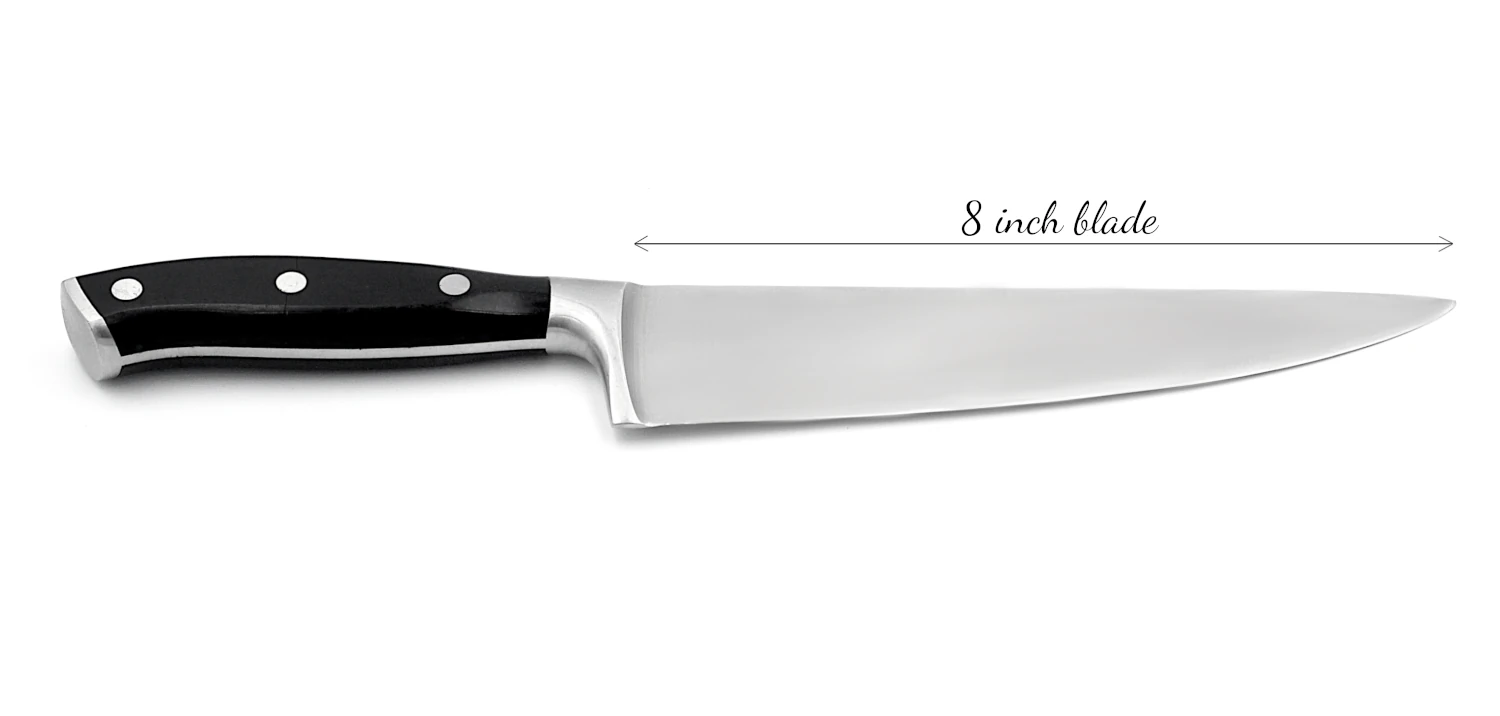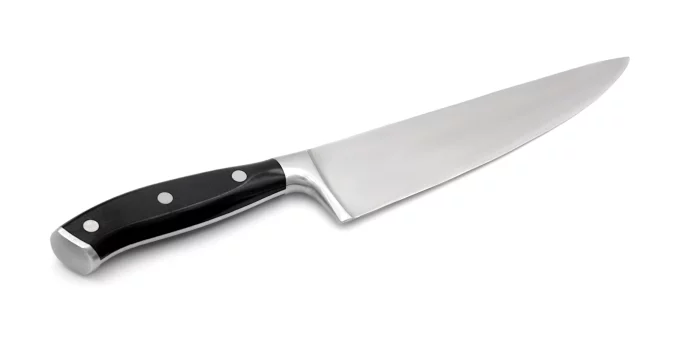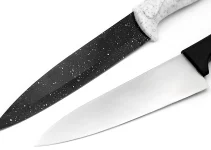Before giving you an in-depth answer to the question how big should a chef’s knife be, let me give you my personal take on this.
This is just what I can say from my personal experience. Some people are certainly going to prefer a different blade size for their chef’s knife.
Before knowing anything about blade lengths or doing any research, I decided to buy a chef’s knife with a 10-inch blade. That was when I started cooking seriously about 15 years ago.
I thought that a longer blade would be better but I don’t remember why I thought that at the time. So I used a chef’s knife with a 10-inch blade for most of my life.
It all changed when I decided to treat myself for my birthday a few years ago to a more expensive chef’s knife. At that time, I came across information that 8-inch is actually the standard blade for a chef’s knife.
So, I got an 8-inch chef’s knife and I was so impressed. It was phenomenal, it was lighter than my 10-inch blade, the blade was more comfortable to slice and dice with, my fingers automatically found the right positioning around the handle and the blade without any conscious thought.
That’s why, my general answer to the question how big should a chef’s knife be is that it should have an 8-inch blade.
On the other hand, professional cooks will prefer a 10 inch blade. Or even a 12-inch one. For most amateur cooks, these bigger length would be harder to handle and get used to.
How Big Should a Chef’s Knife Be?

First, I want to mention that no matter their size, a chef’s knife will always be characterized by a wide blade and a tip that are perfectly designed to allow us that rocking back and forth type of mincing and chopping.
That’s what makes them so absolutely wonderful and one of the most important tools in any kitchen, whether it’s a professional kitchen or it belongs to an amateur cook.
Chef’s knives can come in many sizes: 6 inch, 8 inch, 10 inch, 12 inch, and maybe even 14 inch blades in a few rare instances.
Another unusual size is the 9 inch chef’s knife. However, if you already own an 8 inch and a 10 inch is dauntingly big, then you might be the perfect candidate for a 9 inch blade.
I should also mention that we can eliminate the 6 inch size because it’s quite small for a lot of us.
The standard size of a chef’s knife: 8 inch blade
An 8-inch blade is the standard size for a chef’s knife. If this is your first chef’s knife, you should buy an 8 inch blade because it’s the easiest and fastest to cut with.
It also allows our fingers to be positioned comfortably around the blade and the handle.
Plus, an 8 inch chef’s knife is going to be pretty light. Even if we have to cut a whole bunch of ingredients, your hand will not feel the strain of all that work.
That’s why an 8-inch blade is the perfect answer to this very important question: how big should a chef’s knife be?
Since the 8 inch blade is the standard for Western chef’s knives, it’s also the one we’ll come across the most.
An 8 inch chef’s knife is also cheaper than a 10 inch or 12 inch size. We win on all fronts.
Check out my reviews for the best chef’s knives under $50 if you want to discover some amazing models for affordable prices.
8 Inch or 10 Inch Chef’s Knife?
As I’ve mentioned, the 8-inch blade is the standard for a chef’s knife.
It’s the most popular choice.
And it’s also among the preferred options for many of us because it slices and dices with ease.
The balance point is perfect for slicing and dicing, and if you have a sharp blade you will feel ready to cook for days.
Thus, the 8 inch blade is perfect for fine and precise cutting tasks. It’s also lighter than a 10 inch blade and its shorter blade allows us to work well even if we have smaller cutting boards.
It also offers perfect grip and lets our fingers be positioned perfectly.
On the other hand, a 10 inch blade is imposing, it’s a workhorse and it’s definitely nice to have one around for some situations.
One such situation is you are in the habit of cooking big pot roasts and you want a knife to reach all the way across.
A 10 inch chef’s knife will allow you to make longer single-stroke cuts.
It’s also best for cutting bigger fruits and vegetables, bread and meat.
The 8 inch is great for slicing and dicing most vegetables and for preparing salmon and chicken.
The 8 inch chef’s knife is more versatile
Let’s take into account a few other criteria to compare the two blades.
Weight: about 6 to 10 ounces for the 8-inch and 6.3 and up to 16 ounces for the 10-inch blade. That’s quite the difference between these two.
Blade length: 8 inch (203mm) and 10 inch (253mm).
Overall length (including the handle): 319 mm (12.55 inches) to 381mm (15 inches) for the 8 inch and 575mm (14.76 inches) up to 488mm (19.25 inches) for the 10 inch blade.
All in all, the 8 inch is the more versatile size. If you have the budget for only one piece, I recommend getting a 8-inch chef’s knife as the answer to the question how big should a chef’s knife be.
Gyuto vs German vs French Chef’s Knives
Gyuto is the Japanese version of a Western chef’s knife. They’re certainly not as popular as a German chef’s knife but they are worth considering or at least talking about.
Gyuto translates to mean “cow sword”. They were originally meant for slicing meat, beef in particular. Due to their razor-sharp edge and wide blade gyuto has evolved into a multipurpose knife, similar to the ways we’re all using a chef’s knife in the kitchen.
This multipurpose Japanese knife has an ultra sharp edge with a pointed tip, which is perfect for executing the rocking back and forth type of mincing.
High carbon Japanese steel is used to make gyuto blades.
While Western chef’s knives come in exact sizes like 6, 8, 10, 12, 14 inches and in some rarer cases we can get a 9 inch blade, gyuto knives use different measurements for their blades.
Gyuto blades measure between 180mm and 300mm (between 7 and 12 inches long), while our Western 8 inch blades measure 203mm and the 10 inch ones measure 253mm.
Gyutos come in handy if we’re looking for in-between sizes. We can find 8.25 inch Japanese chef’s knives or blades that measure 9.5 inches or ones that measure 10.5 inches and the 300 mm is the equivalent of just under 12 inches.
Moreover, the balance point for a gyuto is generally further up on the blade’s edge. It can provide the cook with more agility and precision and the blade can be slightly lighter and thinner.
German chef’s knives have a more curved section at the front of the blade, which is perfect for the rocking motion.
French chef’s knives are straighter and more triangular, which works perfectly for slicing where the knife is drawn straight back toward you.
What are chef’s knives made of?
Nowadays, most knives, whether it’s a chef’s knife, a butcher’s knife, a fish fillet knife, a bread knife, etc. are made of carbon steel.
You’ll also find mentions of high carbon steel.
The other two options for materials are: stainless steel and ceramic.
High carbon steel is considered the best material for knives because they come with a razor-sharp edge that maintains its sharpness for longer.
However, carbon steel also has its flows. I totally agree that it’s a wonderful material but there are some things to keep in mind.
The main thing to pay attention to is that carbon steel or high carbon steel can rust. Stainless steel doesn’t rust so that’s actually the main difference between the two.
In order to protect a carbon steel blade, I recommend:
- washing it by hand
- completely drying it off immediately after
- and using food-grade mineral oil for durability
Stainless steel knives can be just as razor-sharp and they can also be easier to sharpen at home.
You might think that ceramic knives should be some of the cheapest and I always have that impression as well.
However, if we take the Kyocera Revolution 8” Ceramic Chef’s Knife that costs a little under $100, then we’ll see that we’re wrong to think that ceramic blades are cheap. It turns out that high carbon steel chef’s knives might be some of the cheapest.
For example, the Mercer Culinary Ultimate White Chef’s Knife costs less than $20. And it’s made of high-carbon Japanese steel.
I guess the lesson is that we shouldn’t make assumptions.
Among my absolute favorite chef’s knives is the Victorinox Fibrox Pro Chef’s Knife, 8-Inch.
How to cut with a chef’s knife
In my opinion, it’s much easier to position our fingers in the position they need to go if we’re using an 8 inch chef’s knife. A 10 inch blade might make things trickier for a while.
Let’s see how we position our hand around the knife.
Our thumb and forefinger will actually be wrapped around the blade, just where it meets the handle.
Our two first fingers being right on the blade will make the knife an extension of our arm. It will give us precision and better control in cutting. Our hand also has a relaxed control over the entire knife. It allows us to do some heavy cutting without getting tired.
The rest of our three fingers will be wrapped around the handle.
Nowadays, handles are quite light. Most are made from plastic (polypropylene ) or rubber. And we can even get aluminum handles.
Polypropylene might be my favorite.
I don’t prefer wooden handles because they are porous so they can harbor bacteria. And they can warp or crack.
Pretty much all handles offer an ergonomic grip. And they’re non-slip, even when wet.
When we’re cutting herbs or mincing garlic, we might bring our free hand to rest on top of the blade. It’s just a natural movement that directs the blade for a fine mincing of garlic or to finely chop herbs.
An 8 inch chef’s knife also has a very wide blade so we can use the blade to crush garlic. Or we can use it to scoop up ingredients from the cutting board and transfer them to the pan.
The same goes for a 10 inch blade but the 8 inch size is all around easier to work with so that’s my answer to the question how big should a chef’s knife be.



